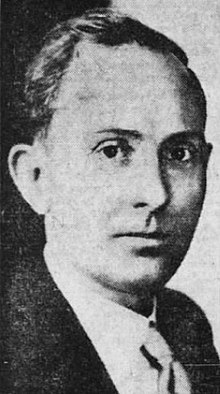Thomas Vernor Smith | |
|---|---|
 The Star Press (Muncie, IN), June 7, 1938 | |
| Member of the
U.S. House of Representatives from Illinois's at-large district | |
| In office January 3, 1939 – January 3, 1941 | |
| Preceded by | Lewis M. Long |
| Succeeded by | William Stratton |
| Member of the Illinois Senate | |
| In office 1935-1938 | |
| Personal details | |
| Born | April 26, 1890 Blanket, Texas |
| Died | May 24, 1964 (aged 74) Hyattsville, Maryland |
| Political party | Democratic |
Thomas Vernor Smith (April 26, 1890 – May 24, 1964), who wrote under the byline T. V. Smith, was an American philosopher, scholar, and politician from Illinois, as well as an officer in the United States Army.
Biography
Smith was born in a log cabin in Blanket, Texas, on April 26, 1890. He graduated from the University of Texas at Austin in 1915, and from the University of Chicago in 1922. Smith entered the Army during World War I and served as a private until discharged on January 28, 1919. [1]
Smith was a member of the faculty of Texas Christian University from 1916 to 1918. After his military service, he resumed his academic career in philosophy at the University of Texas from 1919 to 1921, and he served as a dean and a teacher of philosophy at the University of Chicago from 1922 to 1948. He earned a doctorate from the University of Chicago. His dissertation was "The American Doctrine of Equality." He authored numerous books, many articles, and served as editor of the International Journal of Ethics from 1931 to 1948. Smith began his political career as a member of the Illinois State Senate from 1935 until 1938, during which he authored a number of bills to aimed at reforming the legislative process. He was the chairman of the Illinois Legislative Council in 1937 and 1938. Smith was subsequently elected as a Democrat to the Seventy-sixth United States Congress, from January 3, 1939, through January 3, 1941. Smith failed to be reelected in 1940 for another term. He subsequently published an article titled "Is Congress Any Good, Anyhow?" His response to the question he posed was that in spite of "its pestiferous ways, yes, Congress is some good." [2]

During World War II, Smith returned to the Army as a lieutenant colonel and later as a colonel, serving from 1943 to 1946. He was the director of education of the Allied Control Commission in Italy from November 24, 1943, to November 11, 1944. The Italian scholar and translator, Thomas G. Bergin worked under Colonel Smith in Salerno immediately after the Nazi army had retreated towards northern Italy. Bergin described his experience with Smith, saying. "I could not have wished for a more inspiring or sympathetic chief." Bergin described the purposes of the Education Sub-Commission under Smith in war-torn Italy were to provide first aid and defascistization to the school system, then to hand the administration back to the Italian Government: "The readjustment in educational matters … called for patience, tact and good will on both sides. Col Smith had all those virtues." [3] Adding to the challenges, nearby Mount Vesuvius awoke with one of its most violent eruptions, which overwhelmed five towns. Smith was charged with responsibilities of organizing military efforts to track and mitigate the disaster. [4]
In 1948, Smith resumed his profession as a writer and teacher at the Syracuse University until his retirement in 1959. Smith married Nannie Stewart, they had two children, a son Gayle and a daughter Nancy. [5] He resided in Hyattsville, Maryland, until his death there on May 24, 1964, Smith is interred at Arlington National Cemetery.
Further reading
- Marguerite Martyn, "'Women Are Born Politicians,'" St. Louis Post-Dispatch, May 25, 1936, image 32 (interview and photograph)
External links
- Works by or about Thomas Vernor Smith at Internet Archive
- Guide to the Thomas Vernor Smith Papers 1934-1945 at the University of Chicago Special Collections Research Center
References
- ^ "T. V. Smith, Dead; Ex-Professor at Syracuse Served in House, 1939-41." New York Times. May 25, 1964
- ^ "T. V. Smith, Dead; Ex-Professor at Syracuse Served in House, 1939-41." New York Times. May 25, 1964
- ^ [1] Bergin, Thomas G. "Salerno-Naples. February–March 1944". Italica, Vol. 24, No. 1 (Mar., 1947), pp. 57-61. Published by: American Association of Teachers of Italian
- ^ Smith, T. V. A Non-Existent Man; An Autobiography. University of Texas Press. (1962). p. 188. ISBN 9780292749757
- ^ "T. V. Smith, Dead; Ex-Professor at Syracuse Served in House, 1939-41." New York Times. May 25, 1964
- 1890 births
- 1964 deaths
- Democratic Party Illinois state senators
- United States Army officers
- Texas Christian University faculty
- United States Army personnel of World War I
- University of Texas at Austin alumni
- University of Chicago alumni
- Burials at Arlington National Cemetery
- Democratic Party members of the United States House of Representatives from Illinois
- 20th-century American legislators
- United States Army personnel of World War II
- 20th-century Illinois politicians